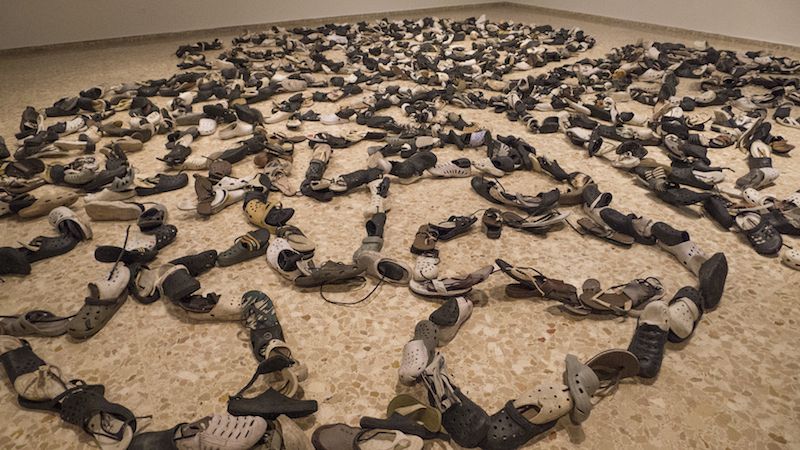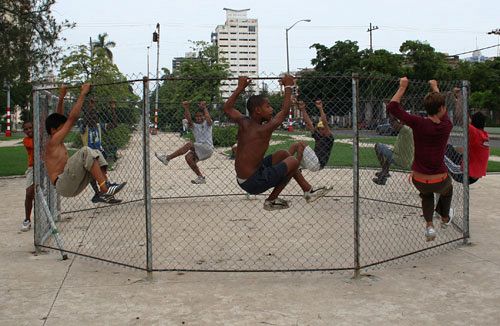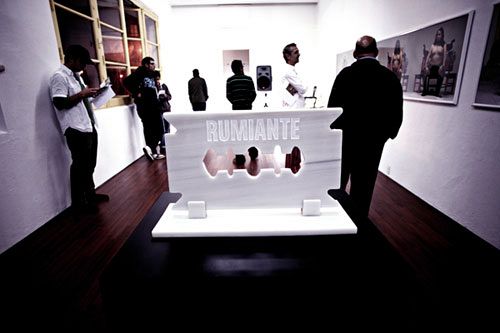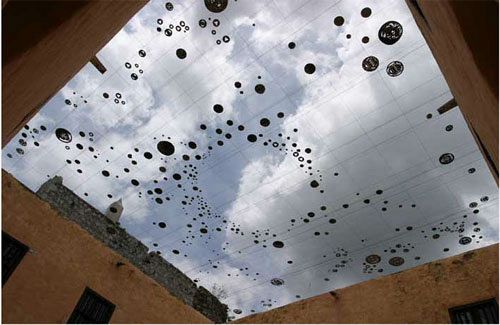Leah Gordon and Andre Eugene, recipients of the 2015 CPPC Travel Award, share their experiences from their research trip to Trinidad in September 2015 (Part 2 of 2, read Part 1 here).
Wednesday 15th September
We went to visit performance artist Tracey Sanker, who has studio space at Granderson Lab in Belmont in Port of Spain. Granderson is a satellite space from Alice Yard; it has about five artists working upstairs in the studio space and also holds screenings, shows, and performances there. Much of Sanker’s current work is based around variations of traditional carnival characters, as opposed to the bikinis and sequins or the larger production spectacular mass outings of costumes organized by workshops such as Peter Minshall’s place. She does a number of different masquerades including one that has been informed by the Vodou spirit Erzulie Dantor that she calls Ladablisse.
When asked if she identified as a contemporary artist or as a carnival performer, she replied that she embraces it all. She identifies as a contemporary artist as much of her work deals with contemporary dance and costume design, but it is fused with carnival characters and story telling. Again I was finding another artist embracing the carnival but the most radical aspect of her work, in my opinion, was to grasp it back from the masses, the state and the commercial, and instead make it private, emotional and reference the traditional, historical carnival.



Images: Tracey Sanker
Maria Numes works as a photographer and documents the traditional carnival. She offered to drive us up in the mountains to Paramin: this is a village located on one of the highest points of western area of the Northern Range in Trinidad. It is a sprawling, steep and mountainous village whose residents have traditionally been farmers, producing herbs like chives, thyme and parsley, as well as vegetables like tomatoes and yams. Paramin is where the descendants of the French Creole migrants still live who came to Trinidad from 1792.
We visited a small bar on the steep journey into the mountains. Eugene and I could speak to the older generation we met there in Kreyol, although they mentioned that since the paved road had been built into the area the younger members of the community are speaking less and less Kreyol. But this, as we had seen in Kim Johnson’s film, was still the crucible for the carnival traditions which had a lot of resonance with the characters we see on the streets of Jacmel in Haiti.
Maria took us to meet two members of the blue devils, who have similarities with the Lanse Kod of the Haitian Jacmel tradition. The blue devils are a form of the Jab Molassi, who cover their bodies in molasses, but in the case the mixture has blue laundry tablets added to produce the intense blue coloring. We met with Steffano Marcano and Jeron Pierre, both in their twenties, who live and farm in the mountains and keep the blue devil tradition alive. They feel that they have an ancestral precedent and legacy that they must honour. Also it is a form of creativity and reinvention and each year they feel that they have to stretch their performance, the movements, the dances, and the characters. So they believe that this is not a static art form at all.

Image: Maria Numes
Image: Steffano Marcano.
That evening we were invited onto Talk City 91.1 FM with with Shabaka Kambon (son of Khafra Kambon, central figure in the Black power movement of the 1970s). We discussed the research and the demonization of Haiti within the Caribbean region; Shabaka spoke about honouring the legacy of the Haitian revolution. We also discussed the situation in the DR but not without recognising that Haitian citizens are the only members of Caricom who have to apply for a visa to come to Trinidad, and Eugene was close to being turned down without a diplomatic intervention.

Image: with Shabaka Kambon at Talk City 91.1 FM.
Thursday 17th September
We drove to visit Shalini Seereeram's studio in central Trinidad, an Indian-Trinidadian area. Seereeram is a multi-media artist/sculptor. She showed us her studio and work.


Images: artist Shalini Seereeram.
Friday 18th September
We met with Sean Leonard who showed us Alice Yard, which is the backyard space of his family’s house in Woodbrook, Port of Spain.
Alice Yard is administered and curated by architect Sean Leonard, artist Christopher Cozier, and writer and editor Nicholas Laughlin. Alice Yard is “a space for creative experiment, collaboration, and improvisation.” They also run a residency and we found that the Haitian artist Tessa Mars was scheduled to start a three-month residency the next month. Again we discovered a link to carnival in that most carnival steel pan groups are organized via community and neighbourhood groups called panyards. The yard in one way refers to the enclosed space where they rehearse but also refers to a grassroots form of collective creative organizing. We saw the residency space, accommodation, and the eponymous yard where the collective dialogues, screenings, talks, performances and interventions take place.

Image: Sean Leonard.

Image: Alice Yard.
In the evening Eugene and I had an exhibition of our work, sculpture, tire cut outs and photography (of the Haitian carnival) at a commercial gallery called Softbox. We were invited to give a talk about the Ghetto Biennale and screened a film about Atis Rezistans. This was really well attended and a good social way of saying goodbye to Trinidad.

Image: Softbox exhibition.
Saturday 19th September
The next day, we met dancer and choreographer Makeda Thomas, who talked about the complexities of cultural exchange between Haiti and Trinidad due to the economic disparity. She traveled to Haiti to collaborate with a number of different dance troupes and choreographers. She questioned whether there could ever be a truly equal relationship and if not, how do we negotiate this? We found this to be a really honest, direct and pertinent exchange as the Ghetto Biennale is trying to ask the same questions. What are the negotiated meshes of legion, exchange and creativity between inequalities?
Later Nurah Cordnar of the National Museum & Art Gallery of Trinidad and Tobago took us to see the Embah exhibition staged at the National Museum. Lastly, we visited the studio of Leroy Clarke who is a renowned, successful artist and the most highly state-funded artist in Trinidad.

Image: Nurah Cordnar at the National Museum & Art Gallery of Trinidad and Tobago.


Image: National Museum.



Images: Leroy Clarke.
The research for this project was made possible by the generous support of ICI and Colección Patricia Phelps de Cisneros (CPPC) through the CPPC Travel Award for Central America and the Caribbean.











